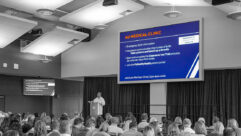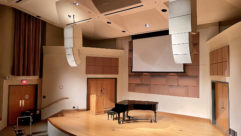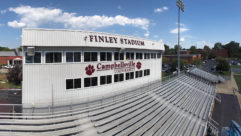
University Installs Custom AV
The University of Notre Dame equips nearly 80 classrooms with custom lecterns that house AV technology with a diminutive footprint.
Talk it outEverything in its placeBEATING THE HEAT
CHALLENGE: Decentralize a university’s AV technology into individual classroom systems that take up as little space as possible without sacrificing ease of use.
SOLUTION: Design and install a compact classroom lectern that houses the majority of the technology in each room and meets professors’ needs.
AS THE FOOTPRINT of classroom technology continues to grow smaller, the behemoth that used to be the classroom lectern is evolving into an entirely different breed. At the University of Notre Dame’s DeBartolo Hall in South Bend, IN, nearly 80 classrooms are equipped with custom lecterns that effectively house presentation technology without taking up much of the valuable space in each room. The new lecterns are the result of collaboration with the university’s instructors.
“It’s terribly important to have the right furniture,” says Dick Mangione, founder and CEO of Antioch, IL-based AV furniture manufacturer Marshall Furniture. “For example, my wife is 4-foot-10 and the guy giving a presentation right after her may be 6 feet tall. We can accommodate all those ergonomics issues, but every group of users will decide those are slightly different. No two universities look at AV the same way. We literally run the gamut from tabletop units that are portable to consoles that are as much as of 130 inches wide to 4 feet deep. At Notre Dame, the lecterns are very small, mobile, and have almost all of the presentation equipment stored inside.”
Nearly 80 classroooms in the University of Notre Dame’s DeBartolo Hall in South Bend, IN, are equipped with Marshall Furniture lecterns. Most of the custom lecterns include a Marshall reading light attached at the top, as well as a Wolfvision VZ8 Plus document camera on a pullout shelf. Each classroom has a ceiling mounted NEC MT1065 LCD projecter that is controlled from the lectern’s Crestron TPS 1700 touchpanel.
Measuring 32 inches wide by 30 inches deep by 38 inches high, Mangione says that Notre Dame’s lecterns are the most compact units the company has built in this quantity. A few years ago, Notre Dame used a standard lectern design that was large enough to house two desktop computers. Because DeBartolo Hall was originally designed in 1992 with a building-wide video distribution system, housing AV equipment wasn’t an issue. Classroom lecterns — many built by the university carpenter shop — only needed to house computers. Racks and racks of laser disc players and VCRs located in a basement control center enabled professors to call up source videos already cued up from control panels in their classrooms.
While it was originally a showcase AV system, the centralized system eventually became more difficult to use and harder to maintain as technology changed over time. With more and more of the components breaking down, the university decided to decentralize its AV technology in 2004.
“We wanted to provide classrooms in which our instructors could be more self sufficient and effectively use technology without the risk of losing valuable class time because the technology didn’t work or the system was too complicated,” says Jason Railton, Notre Dame’s supervisor of classroom support.
Working with the school’s AV dealer, Granger, IN-based Vista Presentation Solutions, the Notre Dame technology staff decided that a multimedia lectern would offer the best use of space. However, with so much technology moving into the classroom, they feared that the size of the lectern would become unmanageable.
Technology staff members began thinking about how the design could be improved. “Basically we stood behind it and tried to use it,” says Rick Nimtz, teaching and learning technology engineer at Notre Dame.
In the end, the staff took its ideas to Vista Sales Consultant Jim Hevel, who turned to Marshall Furniture to create a custom solution. “We try to take the approach that smaller is better with most of the projects we work on,” Hevel says. “We don’t want to have this beast in the room. Marshall designs products with the intent of housing electronics, so they know all of the issues, like proper ventilation and cooling (see sidebar). They’re very sensitive to weight loading and proportions. They won’t build the podium if they think the weight is going to be unsafe.”
Mangione agrees that safety is a top concern. “Our job is to implement our customers’ ideas while keeping them from walking into any propellers,” he says. “We’ll step in if an idea poses a human threat or compromises the life of the furniture, but otherwise we’re here to help them do whatever they want.”
Railton says the school’s instructors offered the necessary input to devise an appropriate solution. “They provide us with ideas on how to further improve the design,” he says. “They use the lecterns every day and are a great resource for improvements, not only to the lecterns, but to classroom technology in general. The manufacturer has been very helpful in taking our requests and turning them into design changes.”
It’s important that the parties involved in a project communicate from the very beginning, as Marshall did with Notre Dame and Vista. “It helps if we know what equipment is going to be used, so we know how much space to leave for the wiring and the opening,” Mangione says. “Sometimes, when you’re dealing with schools, there are a lot of people involved. One guy’s using Crestron, another likes AMX, and the holes are a different size. If we don’t have that all worked out before we build 10 of these things, it’s a huge problem.”
In fact, Notre Dame started with a fairly traditional lectern style that underwent several changes as instructors put it to practical use.
“Our first podium had two levels on the top,” Nimtz explains. “The keyboard sat at the front of the top surface, and the monitor sat a little lower in a well about 18 inches back. That way, the monitor wouldn’t block the professor’s view. We started out with a slanted surface, but decided we could type on a flat surface instead. Then we took the pencil cup off the front and made it easier to use.”
The earlier lectern models included a back wall or dashboard at the top, which was eventually removed to increase the area of the top surface. The team also eliminated the well where the monitor was located. Because professors carry a lot of books along with their laptops, they came up with a shelf that pulls out from the side of the lectern and can hold books, notes, or a document camera. Early versions also included a control panel embedded in the surface, but it was blocked when professors opened their laptops. To solve the problem, Vista suggested that future touchpanels be bolted to the front of the lectern to ensure accessibility.
“A lot of ideas came from interacting with faculty,” says Brian Burchett, Notre Dame’s manager of classroom and cluster services. “It wasn’t always a direct request for a change to the podium, but ‘I need a place to put my books,’ or ‘I want to put my laptop up here, but with your monitor and your keyboard, there’s not enough room.’”
Over time, the team also eliminated the doors on the front of the lectern because they got in the way. Instead, the university went with a locking back panel, which provides easy but secure access to cables and connections. “It’s not a door, per se,” Burchett says. “It’s a panel that drops into a frame and locks. Basically the locking mechanism locks the panel in place. Without a key, you really have nothing to pry it open with.”
“We now have Denon DVD and Samsung SV5000 VCR players rack-mounted in all of the lecterns, and although we can still route TV channels to each room, faculty can control their own input devices using a Crestron TPS 1700 touchpanel,” Burchett says.
The lectern’s locking rear panel provides Notre Dame’s technology staff with access to cabling and equipment, but prevents unauthorized “home remedies” when problems occur. A floor-level opening enables air to flow upward and around the AV equipment housed snugly inside.
Most lecterns also include a Marshall reading light attached to the top of the lectern and a WolfVision VZ8 Plus document camera located on the pullout shelf. In addition, each classroom has a ceiling-mounted NEC MT1065 LCD projector that’s controlled from the lectern’s touchpanel.
“The Marshall lecterns have become a combination of a device rack placement center and a standard lectern,” Burchett says. “Some of our rooms have installed computers inside the podium. Others are equipped only for laptop connections, so the tabletop is empty.”
To date, the university has ordered 80 lecterns, and plans to order more. With a cost of $20,000 per room for both the AV equipment and lectern, the overall project hasn’t been inexpensive, but Mangione says that cost wasn’t the only concern. “At universities like Notre Dame, it’s not so much the money thing,” he says. “This is a rough environment year after year, and our clients have learned they can trust us to support what we build long after the five-year warranty is up. And they can get what they want. A professor doesn’t want to be standing behind something that looks like it was dragged in from the seventh grade.”
The professors also want classroom technology that’s easy to use. “Technology’s always changing,” Nimtz says. “So anytime we can make something more intuitive, it’s good. The best thing they can say about any technology is, ‘I don’t have to think about it. It just works.’”
FOR MORE INFORMATION
Crestronwww.crestron.com
Denonwww.usa.denon.com
Marshall Furniturewww.marshallfurniture.com
Samsungwww.samsung.com
WolfVisionwww.wolfvision.com
When Antioch, IL-based AV furniture maker Marshall Furniture designs its AV lecterns it knows the laws of physics will help keep the equipment from overheating. Because the coolest air in any room can be found near the floor, Marshall starts by installing a 10×10 powder-coated aluminum mesh vent, which is strong enough to hold equipment, flush with the lectern floor. The company also builds a 3/4-inch gap around the perimeter at the bottom of the unit.
“That allows cold air to flow along the floor up into the lectern,” explains Dick Mangione, founder and CEO of Marshall Furniture. “That cold air, as it picks up heat from the equipment, wants to rise. If you provide a place for it to come out the top without fans, you can get quite a powerful chimney effect.”
Aesthetics also come into play when including openings in the top of a lectern. At the University of Notre Dame’s DeBartolo Hall in South Bend, IN, the openings of the classroom lecterns are concealed in many cases. “We try to put nice looking, unobtrusive vents in the very top,” Mangione says. “We hide them behind a 3/4-inch ridge that separates the very top edge of the lectern from the control panel.”
Typically VCRs and DVD players don’t give off much heat, but power amplifiers are another story. “In that case, they might have to put a half-dozen small fans in the rack itself that blow up over the amps,” Mangione says. “Plus, we can put fans in the floor to start the flow upward.”
Such fans are typically installed inside the lectern to help contain noise that might occur as the fans vibrate or get dirty.
Wendy Ellis is a freelance writer based in the northwest suburbs of Chicago. She can be contacted at [email protected].










